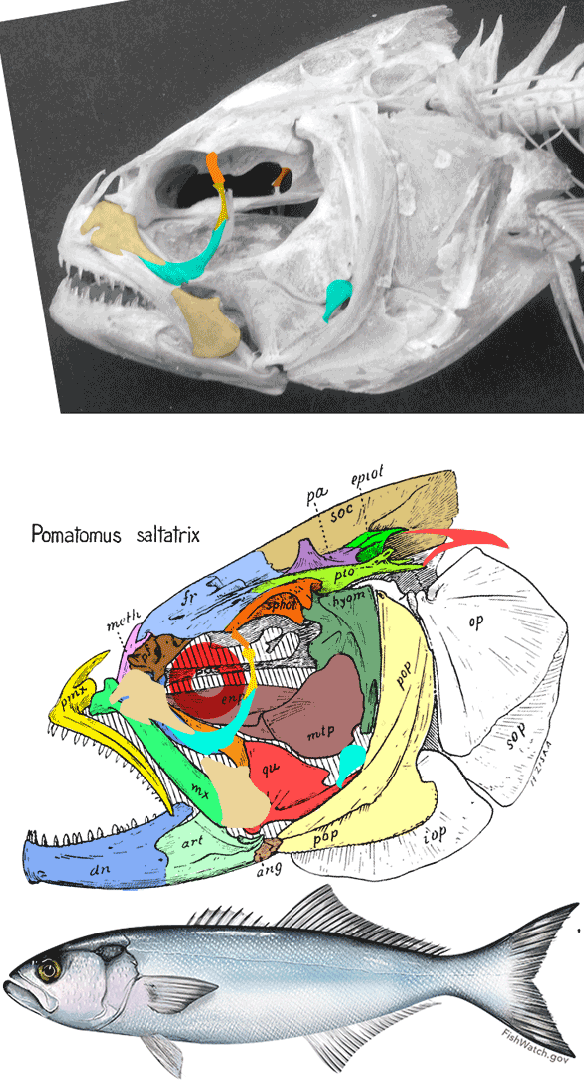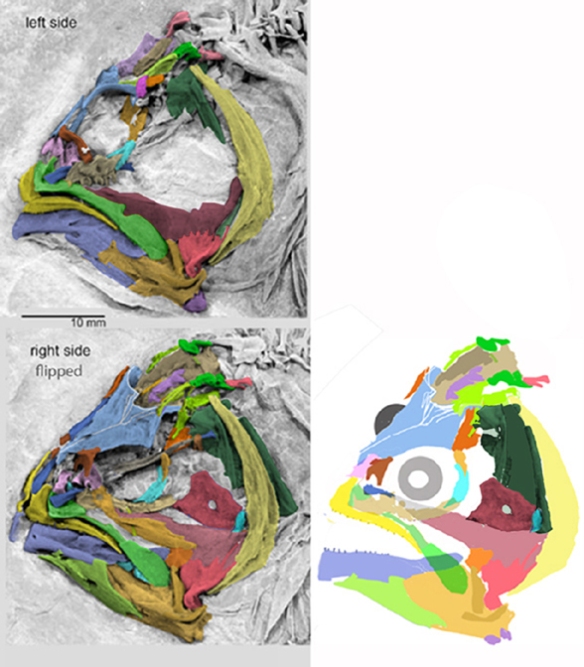Here’s another overlooked hypothetical interrelationship
this time recovered by the addition of taxa not previously tested with flounders, turbot, halibut, plaice, sole, tongue fish, other flatfish and their Eocene ancestors.

Figure 1. Heteronectes is basal to flatfish.
Wikipedia lists several Eocene taxa
with asymmetrical eye placements, but does not go deeper into their symmetrical ancestry.

Figure 2. Amphistium is transitional between Heteronectes and flatfish.
Friedman 2008 and Friedman 2012 brought us
two basal flatfish, Heteronectes (Fig. 1) and Amphistium (Fig. 2), with asymmetric orbits still on opposite sides of the skull. The ancestors of those two taxa are under review here as the large, fast, predator, the bluefish, Pomatomus (Fig. 3), now nests ancestral to these taxa in the large reptile tree (LRT, 1795+ taxa).

Figure 3. The extant bluefish, Pomatomus, is ancestral to flatfish, like Heteronectes (Fig. 2), in the LRT. The circumorbital bones were not present in the Gregory 1933 diagram. They were added here based on the skull above.
Pomatomus saltatrix
(Linneaus 1766; up to 60cm; Fig. 3 is the extant bluefish and basal to flatfish in the LRT. Note the lack of circumorbital bones in the Gregory 1933 drawing preserved in the skull above. This fast-swimming, aggressive, marine pelagic fish is cosmopolitan in distribution. The first dorsal fin spines can be folded iinto a groove. Compare to Hetronectes, a basal flatfish (Figs. 1, 4).

Figure 4. Heteronectes from the Eocene is the earliest known flatfish.
Heteronectes chaneti
(Friedman 2008, 2012; Figs. 1, 4) is an Eocene fish with an assymetric face originally and here considered basal to extant flatfish. Note the presence of circumorbital bones lacking in other, more derived flatfish.
 Friedman 2008 indicated
Friedman 2008 indicated
that the silver sweep, Scorpis (Fig. 5) was ancestral to flatfish. Friedman 2015 sheds no new light on ray-finned fishes. He follows traditional views. Future cladograms need to add taxa, starting with jawless lancelets and including sharks, in order to understand what the LRT(Fig. x) recovered by doing so.
A paper describing bluefish predation on flatfish
is here. Not quite cannibalism, but bluefish are taking big round bites out of their grandkids, in a manner off speaking.
References
Friedman M 2008. The evolutionary origin of flatfish asymmetry. Nature 454:209–212.
Friedman M 2012. Osteology of †Heteronectes chaneti (Acanthomorpha, Pleuronectiformes), an Eocene stem flatfish, with a discussion of flatfish sister-group relationships. Journal of Vertebrate Paleontology (32) 4: 735-756; doi: 10.1080/02724634.2012.661352
Friedman M 2015. The early evolution of ray-finned fishes. Palaeontology 58(2):213–228.
https://pterosaurheresies.wordpress.com/2019/09/29/flatfish-origin-no-longer-uncertain-ca-2008/
